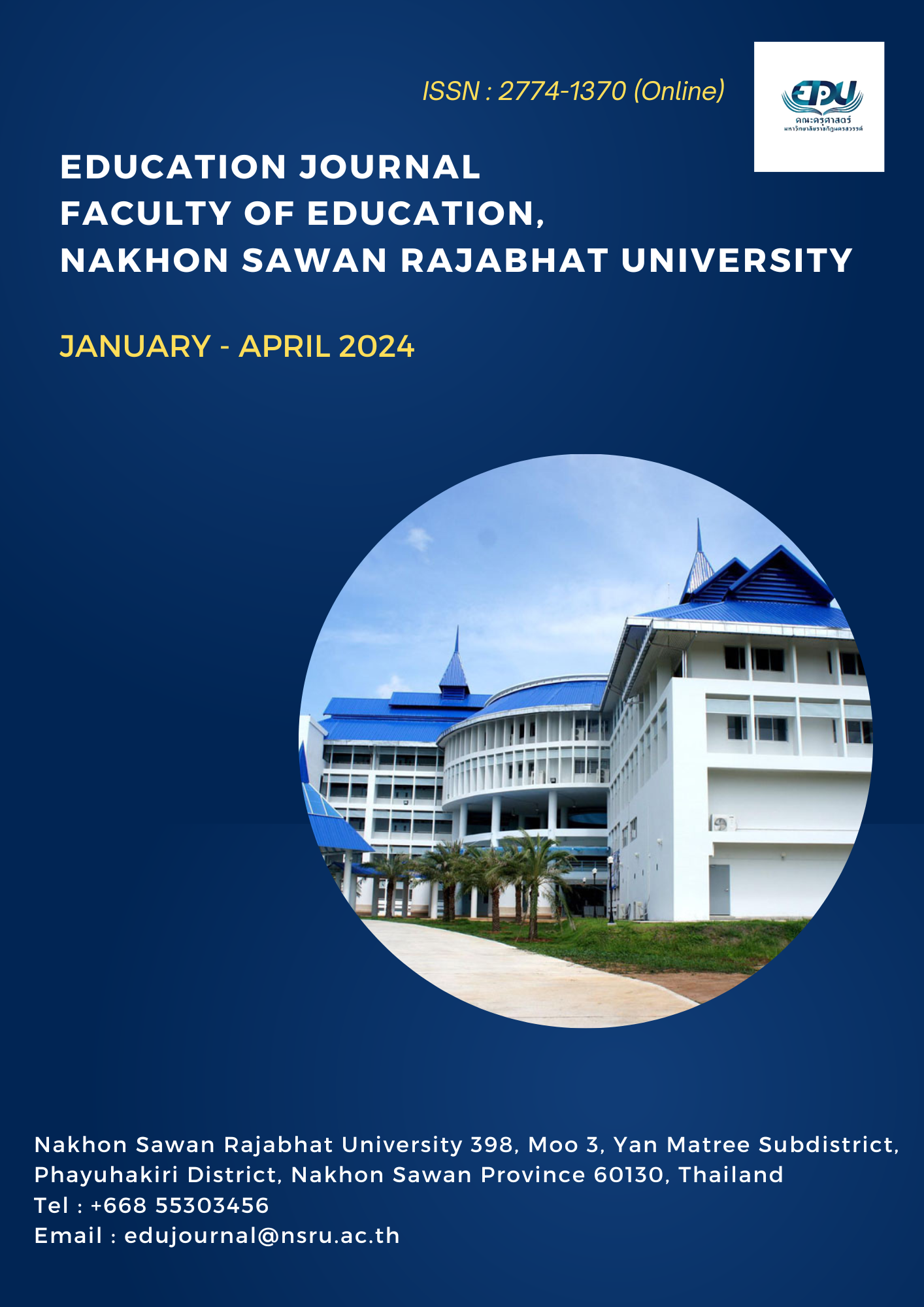Using STEM EDUCATION Management to Develop Creative Problem-Solving Skills in the Uttaradit Lai Phae Fai Tradition of Mathayomsuksa 2 Students
Main Article Content
Abstract
This research aims to 1) study how to use STEM EDUCATION, 2) to develop the creative problem-solving skills of Mathayomsuksa 2 students in Prisms and Cylinders and 3) study the results of developing creative problem-solving skills of Mathayomsuksa 2 students in Prisms and Cylinders using STEM EDUCATION management. The target groups were 2 students studying in the 2nd semester of the 2022 academic year from one of the Educational Opportunity Expansion Schools in Tron District, Uttaradit Province with purposive sampling. The research instruments included activity form, reflective form, students’ tasks, and a creative problem- solving skill test with the reliability level of 0.879. The data were analyzed through content analysis. The findings found that
1) the STEM EDUCATION approach needed 6 steps: (1) problem identification: it concerned the use of a situation that is relevant to students’ everyday lives; (2) data gathering: students should be able to understand the various concepts involved in the situation; (3) process design for problem solving: this encouraged students to use mathematical concepts to solve problems; (4) planning and solving a problem, this enabled students to see the relationship between the mathematical concepts and tasks; (5) testing and improving the tasks, students needed to present them clearly in front of the class and (6) presenting solutions, this allowed students to reflect on how to use mathematical concepts to solve problems or tasks. 2) Students can develop creative problem-solving skills by being able to understand the problem with the best ability but have the least ability to prepare to take an action, and 3) the results of developing creative problem-solving skills were found that in the 1st – 3rd cycles, the students had an average percentage in a good level of 87.5%, 75%, and 87.5% respectively.
Downloads
Article Details

This work is licensed under a Creative Commons Attribution-NonCommercial-NoDerivatives 4.0 International License.
References
กิตติ พัฒนตระกูลสุข. (2546). การเรียนการสอนคณิตศาสตร์ในระดับมัธยมศึกษาของประเทศไทยล้มเหลวจริงหรือ. วารสารคณิตศาสตร์. 46(474-475): 54-58.
จิระประภา คำภาเกะ. (2563). การพัฒนาทักษะการแก้ปัญหาทางคณิตศาสตร์ เรื่อง ปริซึมและทรงกระบอก โดยใช้เทคนิคเพื่อนคู่คิดร่วมกับเกมคณิตศาสตร์ ของนักเรียนชั้นมัธยมศึกษาปีที่ 2. วิทยานิพนธ์วิทยาศาสตรมหาบัณฑิต (คณิตศาสตร์). มหาวิทยาลัยศิลปากร.
ทรงยศ สกุลยา, และวนินทร สุภาพ. (2563). การพัฒนาความสามารถในการแก้ปัญหาอย่างสร้างสรรค์ เรื่อง การประยุกต์สมการเชิงเส้นตัวแปรเดียวด้วยกระบวนการคิดให้เป็นคณิตศาสตร์สำหรับนักเรียนชั้นมัธยมศึกษาปีที่ 1. วารสารศึกษาศาสตร์ มหาวิทยาลัยนเรศวร. 22(4): 88-100.
พันธ์ยุทธ น้อยพินิจ, วนินทร สุภาพ, และจักรกฤษ กลิ่นเอี่ยม. (2562). การวิจัยปฏิบัติการเพื่อพัฒนาการจัดการเรียนรู้ เรื่อง ภาคตัดกรวย ด้วยกระบวนการคิดเชิงออกแบบที่ส่งเสริมความสามารถในการแก้ปัญหาอย่างสร้างสรรค์ ของนักเรียนชั้นมัธยมศึกษาปีที่ 4. วารสารพัฒนาการเรียนการสอน มหาวิทยาลัยรังสิต. 13(1): 70-84.
วนัสนันท์ ชูรัตน์. (2564). การพัฒนาทักษะการแก้ปัญหาอย่างสร้างสรรค์โดยใช้รูปแบบการแก้ปัญหาอย่างสร้างสรรค์ร่วมกับอินโฟกราฟิกสำหรับนักเรียนชั้นมัธยมศึกษาปีที่ 5 เรื่อง กรด-เบส. วิทยานิพนธ์การศึกษามหาบัณฑิต (วิทยาศาสตร์ศึกษา). มหาวิทยาลัยนเรศวร.
ศศิธร ศรีวงษ์ญาติดี, และเนาวนิตย์ สงคราม. (2560). การพัฒนารูปแบบการเรียนรู้โปรแกรมหุ่นยนต์ด้วยวัฏจักรการเรียนรู้ 7E เพื่อส่งเสริมความสามารถในการแก้ปัญหาอย่างสร้างสรรค์. Online Journal of Education. 12(3): 185-201.
สามารถ ทองเฝือ. (2557). การเตรียมความพร้อมสู่ประชาคมอาเซียน ปี 2558 ของหน่วยงานผลิตบัณฑิตในมหาวิทยาลัยสงขลานครินทร์ วิทยาเขตปัตตานี. รายงานการวิจัย. มหาวิทยาลัยสงขลานครินทร์.
สิรินภา กิจเกื้อกูล. (2557). การจัดการเรียนรู้วิทยาศาสตร์ ทิศทางสำหรับครูศตวรรษที่ 21. เพชรบูรณ์: จุลดิชการพิมพ์.
สำนักงานเลขาธิการสภาการศึกษา. (2560). แผนการศึกษาแห่งชาติ พ.ศ. 2560 – 2579. กรุงเทพฯ: พริกหวานกราฟฟิค.
สุธีระ ประเสริฐสรรพ์. (2559). สะเต็มศึกษา: ปัญหาจากกระบวนการออกแบบเชิงวิศวกรรม. สงขลา: นำศิลป์โฆษณา.
อรพันธ์ ประสิทธิรัตน์. (2554). รายงานการวิจัย เรื่องการศึกษาสภาพแวดล้อมทางการเรียนของนิสิตคณะศึกษาศาสตร์. มหาวิทยาลัยศรีนครินทรวิโรฒ. กรุงเทพฯ: มหาวิทยาลัยศรีนครินทรวิโรฒ บางเขน.
Lyn, & Donna. (2015). STEM learning through engineering design: Fourth-grade students’ investigations in aerospace. International journal of stem education. 2: 1-18.
OECD PISA Collaborative Problem-Solving Expert Working Group (2013). PISA 2015 draft collaborative problem-solving framework. Retrieved May, 25, 2023, from https://www.oecd.org./pisa/pisaproducts/ Draft%20PISA%202015%20Collaborative%20Problem%20Solving%20Framework%20.pdf.
Roberts, A. (2013). STEM is here. Now what?. Technology and engineering Teacher. 73(1): 22.
Schack, E. O., Fisher, M. H., & Wilhelm, J. (2017). Teacher noticing: Bridging and Broadening perspectives, contexts, and frameworks. New York, NY: Springer International.
Sherwood Horton-Deutsch. (2017). Reflective Practice: Transforming Education and Improving Outcomes. Indianapolis: Sigma Theta Tau International.


